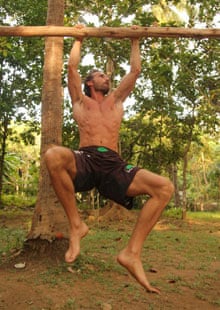
It’s a cold winter’s day and I’m in a park pretending to be an ape. It’s neither the result of consuming hallucinogens nor taking up amateur dramatics. The weatherbeaten man encouraging me believes it’s every person’s right to monkey around in public without attracting worried glances, as to do otherwise is denying our true biological selves.
Erwan Le Corre is the founder of MovNat, a system developed to transform our relationship with exercise by prioritising natural and efficient movement over superficial goals like burning calories. If, so the theory goes, we start running, climbing, jumping, crawling and balancing like the animal species nature intended, then weight loss and muscle tone will follow naturally, along with a general sense of health and wellbeing.
If it sounds bananas, it’s surely no more so than signing up for the traditional New-Year-money-pit of a gym membership. How many of us are already panting away to a Rihanna soundtrack knowing that January’s good intentions will eventually be overwhelmed by sheer tedium?

According to Le Corre, such pessimism is well-founded as he believes conventional fitness to be “a very reductionist and restrictive approach to physical development”. He says: “A sedentary lifestyle is detrimental to health, happiness and longevity but the alternatives that the current fitness industry provide are ineffective and boring because they’re based on goals that don’t understand our evolutionary nature.”
The venue for my introduction to MovNat is actually a temporary ‘ape playground’ in the shadow of London’s Tower Bridge, with ramps, ladders, ropes and climbing frames. The session starts with me lying flat on my back trying to consider the impact of gravity on my body. This is the moment I realise there’s probably more to mastering MovNat than scratching my armpits while pouting and making monkey noises.
Before long, I’m upright and attempting to jump on to a plank from a standing start and land on the balls of my feet. This is quickly extended into an exercise where I have to walk up and down the plank, one foot in front of the other, periodically squatting and changing direction without using my hands for support. Needless to say, were the plank actually a branch in a tall tree, I would quickly have hit the forest floor with a thud.
Next I have to walk along the same plank on all fours. To a MovNat virgin like me, this feels an entirely alien movement and the effort and concentration required to stay on the plank is surprising. As I catch my breath, I think for a moment that Le Corre is calling me a sloth, before realising he is actually suggesting I might like to hang from a bar and move along it in the manner of one of nature’s slackers.
Getting on the bar is relatively easy, traversing it using elbows and knees, less so. If sloths are in this much pain as they hang out, their peaceful faces hide it well. My final challenge is to combine everything into a gruelling circuit.
Anyone witnessing my ungainly foray into MovNat would quickly see that, in biological terms, I’m a mere protozoa in comparison to Le Corre’s higher lifeform. His journey to effortless agility began with a childhood spent outside, climbing trees and sliding down rocks. He later spent time formally studying physical education systems such as Georges Hébert’s Natural Method, a forerunner of Parkour with which MovNat shares some similarities. It was a desire to update some of these concepts of physical education and recapture the unbridled natural energy he felt as a child that led him to devise his own system.
Though it’s unlikely we’ll see local authorities rolling out bespoke playgrounds, MovNat was developed to be adaptable. Le Corre says: “You can use benches, trees, walls, anything man-made. What matters is to use patterns that are universally human. You can exercise indoors catching a medicine ball and you can do the same in the woods with a rock.”
There are plans to introduce a certification system this year so that people can be trained in the UK without needing to attend one of Le Corre’s English-speaking workshops abroad. Clearly, accessibility would need to widen considerably for MovNat to be considered a realistic exercise option for most people but as the Zumba craze and interest in alternative pursuits like Parkour shows, an appetite for novel forms of exercise exists.
You don’t need to believe it’s all been downhill for the human race since our evolutionary split from the chimpanzees to realise there might be something in enjoying movement for movement’s sake rather than worrying about killer abs or beach bodies. The very essence of MovNat encourages you to work out in a different way to normal so it was entirely appropriate that the day after my session I ascended to a previously unknown level of agony. Nevertheless, this purgatory couldn’t change the fact that I’d finished my session with a genuine smile on my face. One could almost say I was grinning like an ape.
To try out a MovNat workshop visit movnat.com
Source: Read Full Article